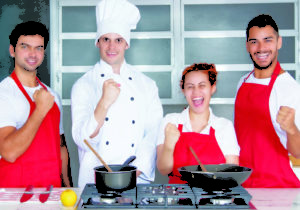
Once this has been done as much as possible, start kneading the dough. With a fork, slowly bring in flour from all sides making sure the walls stay in tact. Using your hands, make a well in the center of the flour making sure the sides are high and even. (If you do not have a food processor– Well Method: Pour flour in a pile on a clean counter top or cutting board. Pulse until the mixture looks like wet sand but sticks together when you squeeze a small piece of it. Put the flour and eggs in a food processor.
#Culinary fundamentals day 19 crack#

Personally, I like my sauce a little chunky 🙂 I’m sure most of you do not have a food mill so another option could be a food processor, blender or even better, an emulsion blender! Again, DO NOT FORGET TO TAKE OUT THE SACHET! The last thing you want is little bits of cheesecloth in every bite of your delicious sauce. Take out the sachet (DO NOT FORGET TO DO THIS) and then run sauce through a medium grate food mill.Season with salt and pepper then let simmer on low for 30 minutes. Add the wine, tomatoes and sachet to the pot.Put the 40 oz of canned tomato in a bowl and with a glove on (or clean bare hands) squish the tomatoes.Use the stems of the fresh herbs and chop into smaller pieces.Add oil to a pot and sweat the onions on medium heat.Fresh Herbs: Basil, Oregano, Tarragon, Thyme.You should at least try it once and preferably with the recipe I am about to share because this recipe is basic– the perfect kind of recipe to build upon to tailor it to your own liking! Are you ready? My mouth may water as I type this out because it’s so good… Although quite possibly overdone, especially when you go in the pasta isle and see an endless variety of red tomato sauce towering over you, nothing, and I mean NOTHING, beats a homemade tomato sauce. The possibilities are endless! The only requirement (obviously) would be tomato and even that may be fresh or canned. They may be raw or cooked, from ten minutes to several hours, smooth or chunky, and may utilize olive oil or other forms of animal fat. Truth is though, tomato sauce is featured in cuisines around the world and can range from fresh and simple to complex and highly seasoned.

Not only do I correlate tomato sauce with Italian rather than the French cuisine I am learning, but also, isn’t this the same stuff people buy so readily from grocery stores labeled as “Pasta Sauce”? I mean, how special is it really?
#Culinary fundamentals day 19 how to#
Prepare hot and cold appetizers and demonstrate how to properly display on a buffet.

Demonstrate proper knife care and handling.Demonstrate proficiency In basic culinary weight and volume measuring and proper recipe conversion, including high altitude adjustments.Identify proper ServSafe sanitation and safety practices.Upon completion of the certificate students will be able to: Courses emphasize fundamental cooking techniques and preparation methods for hot foods, breakfast items, salads, sandwiches, dressings, breads, and pastries. The program provides instruction in culinary concepts and terminology, kitchen safety and sanitation, equipment usage, basic nutritional guidelines, standard and metric measurements, food costing, and theory and practice in the production of culinary products. The Culinary Fundamentals program is designed to equip students with basic skills in culinary arts.


 0 kommentar(er)
0 kommentar(er)
